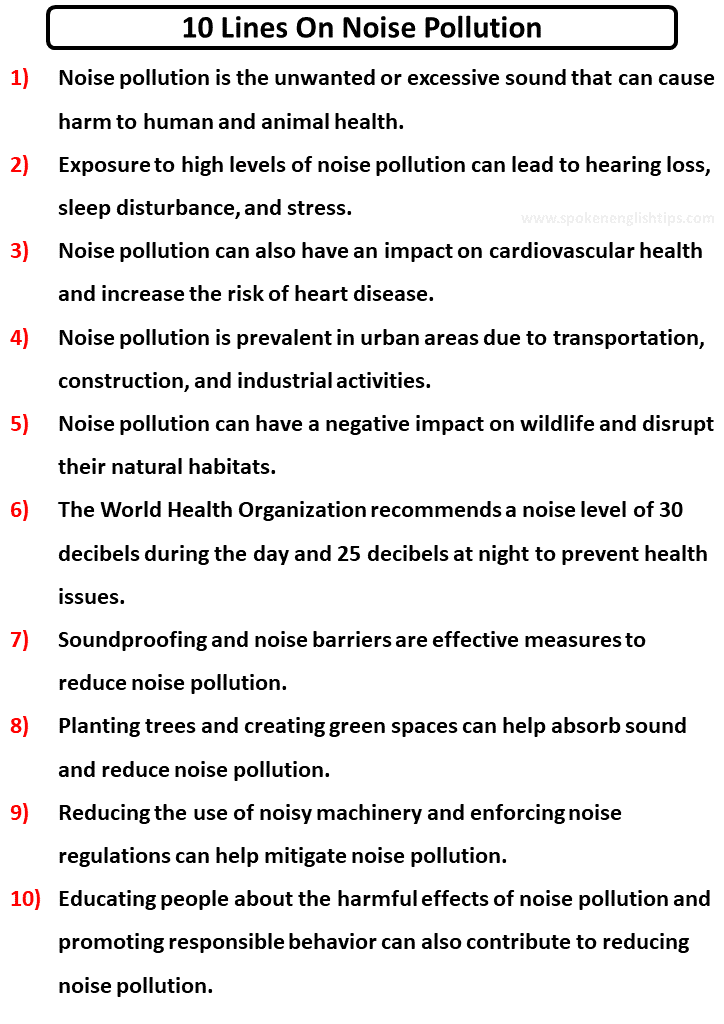Noise pollution is a form of environmental pollution that is often overlooked, but can have severe consequences on our health and well-being. It refers to excessive or unwanted noise that can cause irritation, discomfort, and even harm to human and animal health. Noise pollution is becoming increasingly prevalent in urban areas due to the growth of industries and transportation. In this blog post, we will discuss 10 lines on noise pollution, its effects, and ways to mitigate it.
10 Lines on Noise Pollution:
- Noise pollution is the unwanted or excessive sound that can cause harm to human and animal health.
- Exposure to high levels of noise pollution can lead to hearing loss, sleep disturbance, and stress.
- Noise pollution can also have an impact on cardiovascular health and increase the risk of heart disease.
- Noise pollution is prevalent in urban areas due to transportation, construction, and industrial activities.
- Noise pollution can have a negative impact on wildlife and disrupt their natural habitats.
- The World Health Organization recommends a noise level of 30 decibels during the day and 25 decibels at night to prevent health issues.
- Soundproofing and noise barriers are effective measures to reduce noise pollution.
- Planting trees and creating green spaces can help absorb sound and reduce noise pollution.
- Reducing the use of noisy machinery and enforcing noise regulations can help mitigate noise pollution.
- Educating people about the harmful effects of noise pollution and promoting responsible behavior can also contribute to reducing noise pollution.
20 Lines on Noise Pollution:
- Noise pollution is the excessive or unwanted sound that can cause harm to human health.
- Exposure to high levels of noise pollution can lead to hearing loss.
- It can also cause sleep disturbance and stress.
- Noise pollution can increase the risk of heart disease and other cardiovascular issues.
- It is prevalent in urban areas due to transportation, construction, and industrial activities.
- Wildlife can also be affected by noise pollution and have their natural habitats disrupted.
- The World Health Organization recommends a noise level of 30 decibels during the day and 25 decibels at night.
- Noise pollution can have an impact on cognitive development in children.
- It can also lead to communication difficulties, especially in elderly individuals.
- Noise pollution can cause annoyance and irritability in individuals.
- It can lead to decreased productivity in work and academic settings.
- People who live near airports or busy highways are at a higher risk of noise pollution.
- Music played at high volumes can also contribute to noise pollution.
- Noise pollution can cause hearing impairment in pets such as dogs and cats.
- It can also affect marine life and cause disorientation and hearing loss in whales and dolphins.
- Loud noises from construction sites can cause damage to nearby buildings and infrastructure.
- Noise pollution from vehicles can contribute to air pollution and global warming.
- Noise barriers and soundproofing can help reduce noise pollution in buildings and public spaces.
- Creating green spaces and planting trees can also help absorb sound and reduce noise pollution.
- Education and awareness campaigns can help promote responsible behavior and reduce noise pollution levels in communities.
Conclusion:
Noise pollution is a serious issue that can have long-lasting effects on our health and the environment. It is essential to take steps to mitigate noise pollution, such as reducing the use of noisy machinery, creating green spaces, and enforcing noise regulations. By educating people about the harmful effects of noise pollution and promoting responsible behavior, we can work towards a quieter and healthier world.

FAQs on Noise Pollution
What is noise pollution?
Noise pollution is a form of environmental pollution that refers to the excessive or unwanted sound that can cause harm to human and animal health.
What are the sources of noise pollution?
Sources of noise pollution include transportation, construction, industrial activities, music, and loudspeaker systems.
What are the health effects of noise pollution?
Exposure to high levels of noise pollution can lead to hearing loss, sleep disturbance, stress, cardiovascular issues, communication difficulties, and cognitive development problems.
How can noise pollution be reduced?
Noise pollution can be reduced by implementing noise regulations, reducing the use of noisy machinery, soundproofing buildings, creating green spaces, and promoting responsible behavior.
What are the recommended noise levels by the World Health Organization?
The World Health Organization recommends a noise level of 30 decibels during the day and 25 decibels at night to prevent health issues.
Can noise pollution affect animals?
Yes, noise pollution can affect animals, disrupt their natural habitats, and cause hearing impairment or disorientation in some species.
What are the effects of noise pollution on marine life?
Noise pollution can cause disorientation, hearing loss, and even death in marine life such as whales and dolphins.
How can individuals protect themselves from noise pollution?
Individuals can protect themselves from noise pollution by wearing earplugs, avoiding exposure to loud noises, and using noise-canceling headphones.
How can industries and construction sites reduce noise pollution?
Industries and construction sites can reduce noise pollution by using sound-absorbing materials, implementing noise regulations, and reducing the use of noisy machinery.
How can noise pollution be monitored?
Noise pollution can be monitored using sound level meters, noise dosimeters, and noise maps to identify the sources and levels of noise pollution in a specific area.
Read more:
- The Best 10 Lines on Benefits of Planting Trees
- Attractive 10 lines on importance of water
- 10 lines on Robot in English – Short Essay On Robot
- 10 line poems on poetry out loud – Short poetry out loud
- 10 lines on rainy season – Short Essay on Rainy Season
- 10 lines on Ishwar chandra vidyasagar
- Student 10 lines on discipline– Short Essay On Discipline
- 10 lines on Charles Babbage– Short Essay On Robot
- Short Essay 10 lines on computer
- 10 lines on my Hobby Dancing
- 10 lines on Makar Sankranti
- 10 lines on my family – Short Essay
- 10 lines on independence day – Short Essay
- 10 Entrepreneur Sentences


